What is unbalance control in a washing machine?
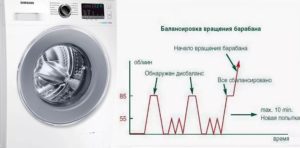 While the housewife calmly waits for the end of the cycle, inside the washing machine, the drum with the laundry scrolls thousands of revolutions per minute. And if outwardly the machine only buzzes slightly and vibrates slightly, then in the machine itself the centrifugal force exposes the device to significant overloads. The negative effect of high-speed rotation is imperceptible due to the imbalance control function integrated in the unit. What this is, how it works and why it is important to monitor the balancing, we will tell in this article.
While the housewife calmly waits for the end of the cycle, inside the washing machine, the drum with the laundry scrolls thousands of revolutions per minute. And if outwardly the machine only buzzes slightly and vibrates slightly, then in the machine itself the centrifugal force exposes the device to significant overloads. The negative effect of high-speed rotation is imperceptible due to the imbalance control function integrated in the unit. What this is, how it works and why it is important to monitor the balancing, we will tell in this article.
Purpose of this function
In short, the control of imbalance in the washing machine is a timely response of the system to the imbalance that has occurred inside the machine. A special sensor detects the uneven distribution of things in the drum or other causes of deviations from the norm and sends a threat signal to the control board. The unit tries to solve the problem on its own, and if it fails, it stops the wash to avoid breakage. Otherwise, crumpled laundry on one side will cause jumps, which will lead to strong vibration, shock and mechanical damage to internal spare parts. The result will be the failure of the bearing assembly, the spider of the shaft and the surface of the drum.
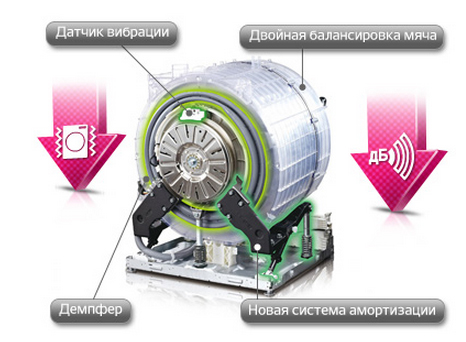
With a functioning imbalance control, this will not happen. The sensor will immediately detect a deviation from the norm, reduce the rotation speed, reduce vibration, stop the cycle and give a warning sound signal. After the owner will remain and independently eliminate the cause of the imbalance, for example, open the door and evenly distribute things in the drum.
All modern washing machines with a spin speed above 1000 rpm are necessarily equipped with an imbalance control function.
It is better after acquiring the machine and before starting the first wash, carefully read the factory instructions. It describes recommendations for eliminating the imbalance on a specific model, and also provides basic rules for operating the washing machine. For example, the main nuance that provokes excessive vibration is non-compliance with the permissible load. Do not forget to take into account that the capacity in kg indicated on the label refers to cotton fabrics. Synthetic materials and wool products are somewhat heavier, so we strictly monitor the weight of the laundry being washed.
Possible causes of imbalance
Most often, an imbalance appears due to exceeding the maximum allowed load and crumpled laundry. As a rule, such a problem is easily solved by opening the hatch, pulling out excess or uniformly shifting clothes along the walls of the drum. It is more difficult if the cause of the disturbed balance of the tank is an installation error or breakdown.
- Not removed transport bolts. Starting a cycle with transport bolts not removed is a serious violation of the operating rules. It should be understood that these clamps are designed to protect the tank during transportation, so the drum compressed by the screws will not be able to fully rotate, but will begin to shake, bounce and upset the balance in the washer. This is extremely dangerous, is not considered a warranty case and occurs due to banal carelessness when installing the machine yourself. There are only four such bolts and they are located on the rear panel of the unit.
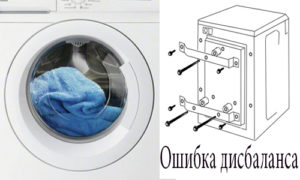
- Unadjusted position. The more stable the machine, the weaker the vibration and the lower the risk of imbalance. Ideally, the machine should stand on a concrete or tiled floor and level with the building level using adjustable legs. Special devices will not interfere - anti-slip mat made of thick rubber or anti-vibration nozzles on the legs. It is not recommended to put the machine on wooden floors, linoleum and carpets.
- Defective shock absorbers.To reduce the risk of imbalance, shock absorbers are also provided in the machine. They help smooth out the jumps of the drum and drown out the vibrations coming from it. If the gaskets are worn out or the fasteners are loosened, then the dampers will not cope with the task. Checking their performance is simple: remove the top cover of the case, press on the tank and evaluate the result. If instead of a sharp jump of 2-3 cm and stops, chaotic swings and jumps begin, then there is a problem - an urgent replacement is necessary.
- Not coping balances. It suppresses centrifugal force from the drum, dampens vibrations and plays the role of shock absorbers and massive artificial load - a counterweight. There are several of them in the machine and they are placed on top, side and bottom of the body, reliably fixing the tank from all sides. When they are destroyed or deformed, automatic unbalance occurs: the vibrations are not held back, the machine starts to jump, and cast-iron ingots or stones made of concrete and plastic beat loudly against other elements of the machine. Therefore, remove the top or back panel and carefully examine the status of the balances. Possible weakening of the retaining bolts, the appearance of chips and cracks. If replacement is required, then we act very carefully - the concrete is very heavy, and if it falls, the parts of the washing machine will easily bend.
Cracks in the concrete counterweight can be easily eliminated if the holes are covered with cement mortar and PVA glue.
- Failure in the bearing assembly. If one of the bearings collapses, then along with the imbalance slow rotation of the drum and clanking will appear during washing and spinning. We do not recommend independently understanding what a bearing unit is and how to repair it. It is easier, more reliable and cheaper to contact the service department for a quicker and more reliable solution to the problem.
No wonder the imbalance control is called the "self-preservation instinct" of the washing machine. Only knowing how to feel the danger is approaching, the machine will be able to stop work in a timely manner, minimize risks and last at least 5-7 years.
Interesting:
Reader Comments
- Share your opinion - leave a comment
Headings
Washing machine repair


For buyers
For users

Dishwasher

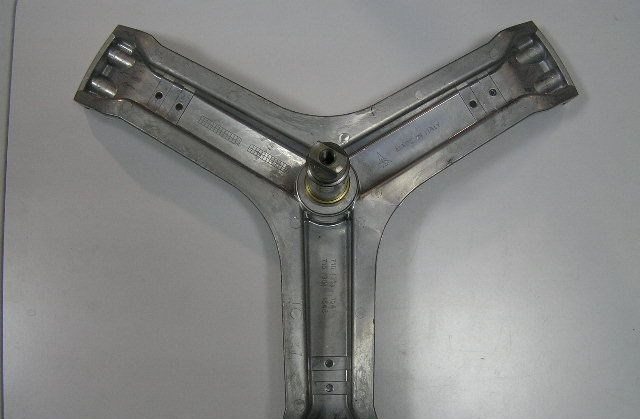
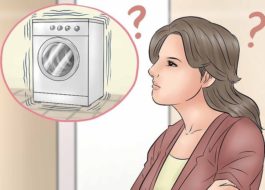

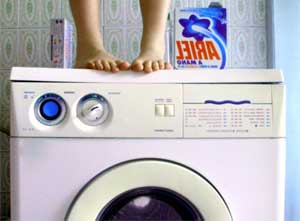
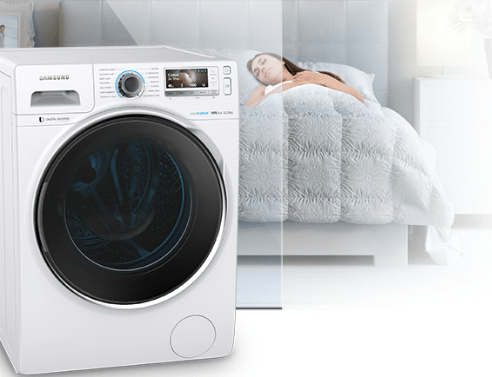












Add a comment